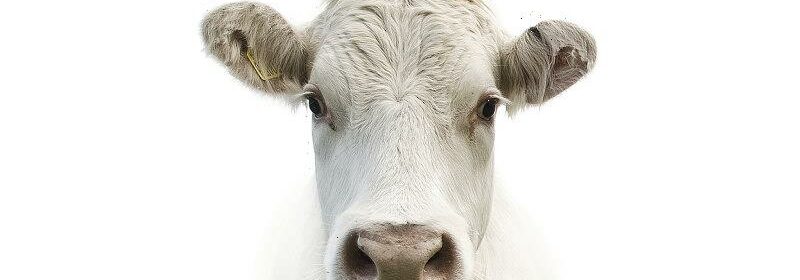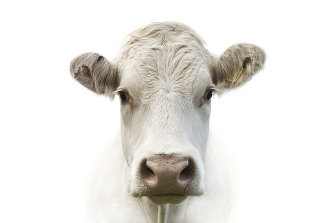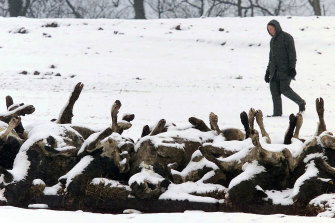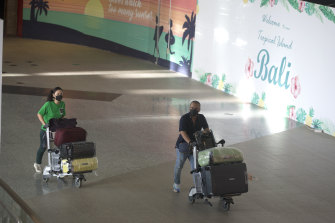What is foot and mouth disease? Can humans catch it?

With foot and mouth disease now in Indonesia, Australia is on alert to stop it spreading here. What is the disease, and why are the stakes so high?
It’s the highly contagious disease that wrought havoc in the United Kingdom two decades ago. Now, viral fragments of foot and mouth disease have been detected in goods coming into Australia.
The federal government has warned that an outbreak could wipe up to $80 billion from Australia’s economy.
While Australia has remained free from an outbreak of the virus for 150 years, where it’s been found at various times around the world it has had devastating consequences.
What is foot and mouth disease? Can it affect humans? And how can we stop its spread?
Credit:
What is foot and mouth disease?
It’s a highly contagious viral disease that affects cloven-hoofed (two-toed) animals, including cattle, sheep, goats, camels, deer and pigs. It spreads among animals through contact with contaminated feed and excretions such as faeces, semen and milk. But it can also be spread through mud or manure sticking to farming equipment, vehicles, clothing and leather, including shoes; as well as on hair, grass and straw; and in the air. It can survive in people’s noses for up to 24 hours.
The disease is one of the most infectious animal diseases in the world – the minimum number of virus particles required to cause an infection is very low.
Animals can be infectious before symptoms appear, says CSIRO-Australian Animal Health Laboratory’s principal research scientist, Wilna Vosloo. “Dairy cattle, for example, can start excreting the virus up to four days before they show clinical signs,” she says. Symptoms can take up to 14 days to appear, usually beginning with a high fever that lasts between two and six days, followed by blisters in the mouth on the gums, on snouts, teats and feet that can be painful when they burst and that take up to 10 days to heal.
“When blisters rupture, there is a tremendous amount of virus in the fluid [that is released],” she says. “[But] there’s also airborne excretion of the virus. Pigs, especially, excrete a lot of the virus through the air.”
Blisters in the mouth can lead to an animal becoming reluctant to eat and blisters on the feet can lead to an animal being unable to walk to food and water and even becoming lame. There’s also the risk of secondary infections (those that develop because bacteria enters the wounds left by the virus, rather than being caused directly by the virus itself) in lesions, particularly on the teats of lactating animals.
There’s no specific treatment either, although a mix of antibiotics and disinfectants is often used to prevent and treat secondary infections. Most animals recover within two weeks, but some may be left weakened or debilitated. And it can affect the hearts of young animals, which can lead to their death.
The first recorded mention of the disease was by a Franciscan monk in Venice in 1546. Then, in 1897, German bacteriologist Friedrich Loeffler was the first to show that the disease was caused by a virus. In Australia, minor outbreaks of what might have been foot and mouth disease are believed to have happened four times in the 19th century, the latest in 1872 when an infected bull was imported from England, leading to the spread of the disease at two properties in Werribee in Victoria.
The UK’s foot and mouth outbreak in 2001 cost about $19 billion.Credit:AP
Can humans be infected with foot and mouth disease?
The disease in humans is extremely rare, usually resulting in mild, blister-like lesions and not causing serious illness. People can be infected through open skin wounds by handling diseased animals, or through the mouth lining by drinking infected milk. They can’t be infected by eating meat from infected animals.
Foot and mouth disease is not to be confused with a similar-sounding ailment – human hand, foot and mouth disease. It causes rashes, ulcers, bumps or blisters in the mouth, palms, fingers and soles of feet, mostly in children. Symptoms last for between seven and 10 days.
Has foot and mouth been found in Australia recently?
Viral fragments of the disease have been detected. These fragments are not live virus so can’t be transmitted. The fragments were in a beef product at an Australian airport. “A passenger travelling from Indonesia has, in recent days, been intercepted with a beef product that they didn’t declare, which tested positive for foot and mouth disease viral fragments,” said Agriculture Minister Murray Watt on July 20.
And routine inspections of pork products from China for sale in Melbourne’s CBD have shown up viral fragments of both foot and mouth disease and African swine fever – another livestock disease that hasn’t previously circulated among animals in Australia. “I’m advised that all products now of this kind have been seized from all linked supermarkets and a warehouse in Melbourne as well,” said Watt.
But the viral fragments have raised concerns that other tainted products could breach Australia’s biosecurity system.
Why is it such a big deal for Australia?
Australia has some of the strictest biosecurity controls in the world, for good reasons. The federal government expects the value of the agriculture sector to reach $81 billion this financial year, $12 billion more than the previous record. All in all, the damage from a foot and mouth outbreak could cost the country $80 billion, the government has said.
Unlike the UK, Australia has tens of millions of feral animals that can spread foot and mouth disease, including 24 million pigs and 6 million goats. Infected feral animals are uncontained and could, potentially, spread the disease between farms even if movements of farmed livestock have been locked down.
The UK foot and mouth disease outbreak in 2001, believed to have been caused by pigs unwittingly being fed infected meat, forced farmers to destroy more than 6 million pigs, cows and sheep, costing an estimated £8 billion. The disease recurred in the UK in 2007, and has broken out in places that had been free of it, including Taiwan in 2009. Japan and South Korea had big outbreaks in 2010.
After more than three decades of being free of foot and mouth disease, Indonesia detected the disease in May. By July 21, there had been 401,205 cases detected across 22 of Indonesia’s 34 provinces, mostly in cows, according to its foot and mouth taskforce, with more than 4000 animals slaughtered and another 2772 dying of the disease.
Its detection and spread on the island of Bali has raised particular concerns here. Most of the 46,000 international visitors to Bali from January to April were from Australia, according to Bali’s Tourism Office. There are at least 204 cases of foot and mouth in Bali, a tiny fraction of Indonesia’s total, but according to local news reports some owners have refused to allow their infected cattle to be slaughtered until they were told what compensation they would receive.
Still, the head of Indonesia’s National Disaster Mitigation Agency and foot and mouth taskforce, Major General Suharyanto, said he hoped Bali would have eradicated the virus within the next week. “We will do conditional slaughtering of cattle in Bali because there are not many,” he said. “Hopefully, there will be no sick cattle in Bali.”
Agriculture Minister Murray Watt said products made from infected animals or objects that have come into contact with them are the biggest risk to the disease entering Australia.Credit:AP
What’s being done to stop the spread?
Foot mats are being rolled out at international airports, starting with Darwin and Cairns, for travellers from Indonesia to walk across on arrival. The mats contain a citric acid solution, which dislodges dirt and covers it in the acid. “We still encourage Australians to clean their shoes and clothing, and even leave their footwear overseas if they can,” said Watt.
Travellers arriving in Australia from Indonesia must declare contact with farm animals. Luggage is being scanned and inspected by hand and officials are boarding aircrafts from Indonesia on arrival to play a message focused on concerns around the disease.
One NSW cattle farmer told The Age and The Sydney Morning Herald when he and his wife returned from Bali recently, they ticked the box saying they had been on a farm – because they stayed at a resort in Seminyak across the road from livestock paddocks – which meant their luggage was checked. Other people on his flight didn’t tick the box because they had not, technically, been on a farm.
Vosloo says returned travellers should not go to farming regions. “If you’ve been in close contact with infected animals, avoid going to a farm, a show with animals and any other places with susceptible animals.”
Both Watt and Vosloo say it’s products made from infected animals, such as dairy and meat products, that pose one of the largest risks to the disease spreading. “Even a sausage or a dry piece of meat or anything like that can potentially have a [live] virus in it,” Vosloo says. “And if that material then gets in contact with pigs and they eat it, that can cause an outbreak, like how people suspect it started in the UK.”
What would happen if there was an outbreak here?
The default policy for an outbreak of foot and mouth is to contain, control and eradicate the disease to re-establish the disease-free status of Australia (see below) as quickly as possible, while minimising social and financial disruption.
The response would begin with a national livestock standstill lasting 72 hours. That would mean an immediate ban on the transportation of any susceptible animals. Animals already being moved could only be delivered if the journey could be completed within four hours, subject to the recipient’s wishes, and not across any state borders. The Department of Agriculture would be contactable for advice if the journey was more than four hours or if there was any uncertainty about the best course of action.
After 72 hours, the focus would move to specific areas where an outbreak had been identified, with some restrictions on the livestock standstill lifted for unaffected areas. State governments would be responsible for investigating where the disease had spread, and the chief veterinary officer of each state would be responsible for implementing a subsequent plan. The general manager of Emergency Preparedness, Animal Health and Biosecurity at Animal Health Australia, Sam Allan, says unless there is a factor “very out of the blue” the chief veterinary officer would follow the guidance outlined in the AUSVETPLAN.
This approach would be guided by the Australian Veterinary Emergency Plan, which includes tracing and surveillance. Australia has one of the world’s leading animal traceability programs, the National Livestock Identification Service, which tracks the movement of all agricultural animals. If foot and mouth disease was detected on a farm, that property would be isolated and any movements of the animals in prior weeks could be traced.
Other measures would include quarantine as well as the slaughter of livestock, with vaccination considered an additional measure.
Can’t we just vaccinate animals already?
Australia’s supply of vaccines is held in the UK because it’s considered too risky to have live samples of the virus in the country, even in our highest-security labs. These supplies would take weeks if there was an outbreak, says Vosloo. “It’s not an already prepared vaccine,” she says. “It’s the inactivated or killed antigen that needs to be formulated into a vaccine, bottled and shipped to Australia.”
Vaccinating animals in Australia when there’s no foot-and-mouth outbreak means a country such as Australia loses its status of being “free of foot-and-mouth disease without the use of vaccines”, under the World Organisation for Animal Health. This makes it more difficult to trade with countries that are disease-free and don’t use the vaccine. “That status is why Australia is doing so well with live exports,” Vosloo says.
If there was an outbreak and we aimed to regain this status, “all the infected animals [would] have to be killed,” says Vosloo.
If the disease were to arrive in Australia and the nation pursues an approach of no vaccinations and only slaughtering infected animals, Australia could reapply for foot-and-mouth-disease-free status three months after the last case was detected. Including vaccinations in our approach would extend that timeline to six months after surveillance showed no evidence of infection.
“A vaccinated animal may still have some virus replication,” Vosloo says. “The vaccine prevents clinical disease but doesn’t necessarily prevent infection. There’s that very, very low risk that the virus might still be circulating in your vaccinated animals.” Vaccinations have a limited shelf-life, too: the protection period is generally 12 months or less.
But not being vaccinated also makes animals in Australia particularly vulnerable to infection, says Vosloo. “Because our animals have not been vaccinated, and they have never seemed to develop the disease, they are highly susceptible.”
If you'd like some expert background on an issue or a news event, drop us a line at [email protected] or [email protected]. Read more explainers here.
Most Viewed in National
Source: Read Full Article


